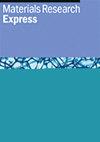将 ZnO 或 TiO2 纳米颗粒分散到蕨类植物茎衍生生物炭上,在可见光照射下高效光催化去除强力霉素抗生素
IF 2.2
4区 材料科学
Q3 MATERIALS SCIENCE, MULTIDISCIPLINARY
引用次数: 0
摘要
通过高温热解法制备了从芦苇茎中提取的生物炭(BC),并通过简单的水解法合成了两种类型的 ZnO/生物炭(ZBC)和 TiO2/生物炭(TBC)复合材料。与纯 ZnO 和 TiO2 相比,这些复合材料不仅改善了结晶结构,而且显著提高了比表面积。ZBC 和 TBC 复合材料物理和化学性质的这种增强是我们研究的一个重要方面,因为它导致了明显的红移吸收边缘和优异的可见光吸收特性。我们以多西环素抗生素作为模拟污染物,在可见光照射下对 ZBC 和 TBC 复合材料的光催化降解效率进行了评估,这是我们研究的一项重要发现。结果表明,与纯 ZnO 和 TiO2 相比,ZBC 和 TBC 复合材料的光催化降解效率分别提高了 6.0 倍和 7.3 倍,进一步凸显了这些增强特性的重要性。此外,活性物种捕获实验表明,-OH 自由基是强力霉素光催化降解过程中的主要活性物种。Langmuir-Hinshelwood 动力学模型准确地反映了这一降解过程。动力学数据表明,ZBC 和 TBC 催化剂的降解速率常数(k)分别为 4.314 × 10-2 min-1 和 3.416 × 10-2 min-1。ZBC 和 TBC 光催化剂的降解效率即使在第四个循环后也没有明显下降,这表明它们具有相对较高的重复利用率。这些结果表明,ZBC 和 TBC 材料可作为稳定、高效、经济和可持续的光催化复合材料用于抗生素污染废水的处理。本文章由计算机程序翻译,如有差异,请以英文原文为准。
Dispersion of ZnO or TiO2 nanoparticles onto P. australis stem-derived biochar for highly efficient photocatalytic removal of doxycycline antibiotic under visible light irradiation
Biochar (BC) derived from reed stems was prepared by high-temperature pyrolysis, and two types of ZnO/biochar (ZBC) and TiO2/biochar (TBC) composite materials were synthesized via a simple hydrolysis method. These composites, compared to pure ZnO and TiO2, exhibit not only improved but significantly enhanced crystalline structures and larger specific surface areas. This enhancement in the physical and chemical properties of ZBC and TBC composites is a crucial aspect of our research, as it leads to a distinct red-shifted absorption edge and excellent visible-light absorption characteristics. The photocatalytic degradation efficiency of ZBC and TBC composite materials, a key finding of our study, was evaluated using doxycycline antibiotic as a simulated pollutant under visible-light irradiation. The results demonstrate a 6.0-fold and 7.3-fold increase in photocatalytic degradation efficiency of ZBC and TBC composites compared to pure ZnO and TiO2, respectively, further underscoring the significance of these enhanced properties. Furthermore, active species trapping experiments reveal that ·OH radicals are the dominant reactive species in the photocatalytic degradation process of doxycycline. A Langmuir–Hinshelwood kinetic model accurately represents this degradation process. Kinetic data indicate that the degradation rate constants (k) of ZBC and TBC catalysts are 4.314 × 10−2 min−1 and 3.416 × 10−2 min−1, respectively. The photocatalysts exhibit no significant decrease in degradation efficiency for ZBC and TBC even after the fourth cycle, indicating their relatively high reusability. These results suggest that ZBC and TBC materials can be used as stable, efficient, cost-effective, and sustainable photocatalytic composite materials for antibiotic-contaminated wastewater treatment.
求助全文
通过发布文献求助,成功后即可免费获取论文全文。
去求助
来源期刊

Materials Research Express
MATERIALS SCIENCE, MULTIDISCIPLINARY-
CiteScore
4.50
自引率
4.30%
发文量
640
审稿时长
12 weeks
期刊介绍:
A broad, rapid peer-review journal publishing new experimental and theoretical research on the design, fabrication, properties and applications of all classes of materials.
 求助内容:
求助内容: 应助结果提醒方式:
应助结果提醒方式:


